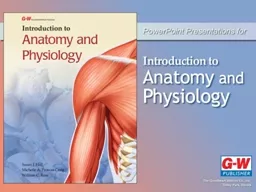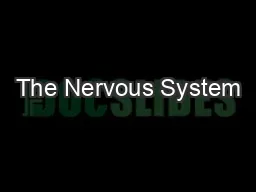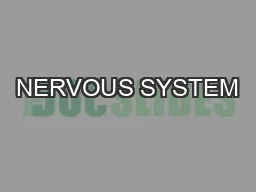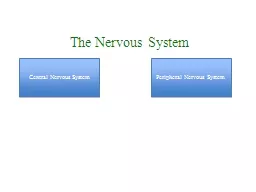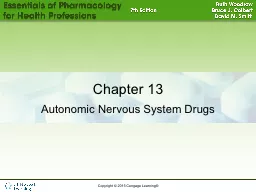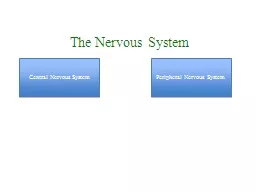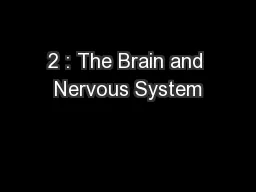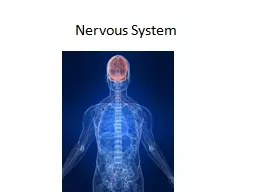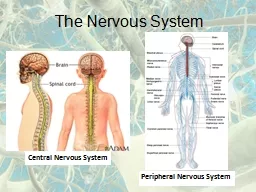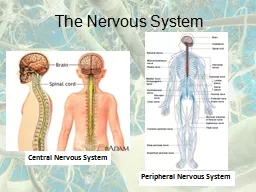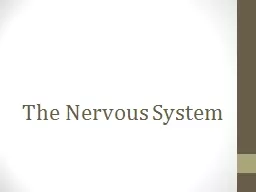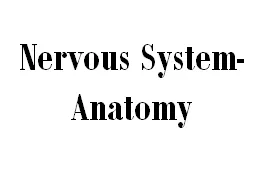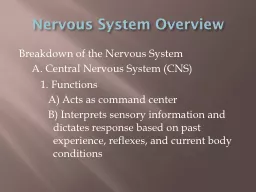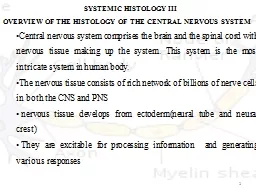PPT-Lesson 6.1 Overview of the Nervous System
Author : broadcastworld | Published Date : 2020-06-16
Chapter 6 The Nervous System Our nervous system has the ability to simultaneously direct multiple functions taking place in in our bodies Two major divisions Central
Presentation Embed Code
Download Presentation
Download Presentation The PPT/PDF document "Lesson 6.1 Overview of the Nervous Sys..." is the property of its rightful owner. Permission is granted to download and print the materials on this website for personal, non-commercial use only, and to display it on your personal computer provided you do not modify the materials and that you retain all copyright notices contained in the materials. By downloading content from our website, you accept the terms of this agreement.
Lesson 6.1 Overview of the Nervous System: Transcript
Chapter 6 The Nervous System Our nervous system has the ability to simultaneously direct multiple functions taking place in in our bodies Two major divisions Central nervous system CNS It directs the activity of the entire nervous system. A. Bacterial Infections of the Nervous System. 1. Bacterial Meningitis. A) Although bacteria can infect the brain, spinal cord, and peripheral nerves, they more commonly infect the meninges and cerebrospinal fluids resulting in meningitis. Functions of the Nervous System. Sensory input – gathering information. To monitor changes occurring inside and outside the body. Changes = stimuli. Integration. To process and interpret sensory input and decide if action is needed. NERVOUS SYSTEM. NERVOUS SYSTEMS RECEIVE SENSORY INPUT, INTEPRET IT, AND SENT OUT APPROPRIATE COMMANDS. NERVOUS SYSTEMS. MOST INTRICATELY ORGANIZED DATA PROCESSING SYSTEM ON EARTH. NEURON. FUNCTIONAL UNIT; SPECIALIZED NERVE CELL FOR CARRYING SIGNALS FROM ONE LOCATION IN THE BODY TO ANOTHER. Central Nervous System. Peripheral Nervous System. The Nervous System. Central Nervous System. The Nervous System. Central Nervous System. Central Core. Limbic System. Cerebrum. The Nervous System. Central Nervous System. Introduction. Autonomic . nervous system (. ANS). A. utomatic. , self-governing, or . involuntary. No . conscious . control. Divided . into . sympathetic (alert system) and . parasympathetic nervous . Peripheral Nervous System. The Nervous System. Central Nervous System. The Nervous System. Central Nervous System. Central Core. Limbic System. Cerebrum. The Nervous System. Central Nervous System. Central Core. Cognitive Neuroscience. David Eagleman. Jonathan . Downar. Chapter Outline. An Overview of the Nervous System. The Peripheral Nervous System. The Spinal Cord. The Brainstem. The Cerebellum. The Diencephalon. Nervous System Nervous System Design 2 main section C entral N ervous S ystem P eripheral N ervous System C entral N ervous S ystem (CNS) brain and spinal cord. encased in skull and vertebral column to protect The Nervous System Central Nervous System Peripheral Nervous System Procedure A starting person will be chosen and will be given an object. Once the teacher gives the signal, the start person will pass the object to their right. The Nervous System Central Nervous System Peripheral Nervous System Procedure A starting person will be chosen and will be given an object. Once the teacher gives the signal, the start person will pass the object to their right. 1. Two main divisions. a. . Central Nervous System . (CNS) – consists of brain and spinal cord. b. . Peripheral Nervous System . (PNS) – includes nerves extending from . brain and . spinal . cord . Brain. Spinal Cord. (also includes 4 chambers in brain called ventricles). Brain. 1) Cerebral Hemispheres. 2) Diencephalon. 3. ) Brain Stem. 4) Cerebellum. 1) Cerebral Hemispheres. Covered by ridges = . A. Central Nervous System (CNS). 1. . Functions . A) . Acts . as command center. B) . Interprets . sensory information and dictates response based on past experience, . reflexes, . and current body conditions. Central nervous system comprises the brain and the spinal cord with nervous tissue making up the system. This system is the most intricate system in human body.. The nervous tissue consists of rich network of billions of nerve cells in both the CNS and PNS .
Download Document
Here is the link to download the presentation.
"Lesson 6.1 Overview of the Nervous System"The content belongs to its owner. You may download and print it for personal use, without modification, and keep all copyright notices. By downloading, you agree to these terms.
Related Documents

